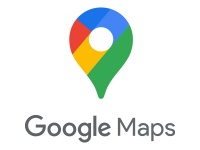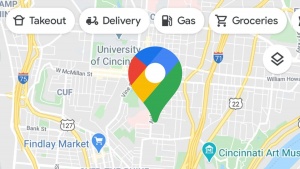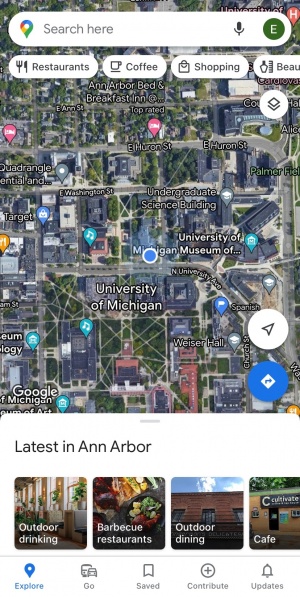Difference between revisions of "Google Maps"
| Line 87: | Line 87: | ||
==== Misuse ==== | ==== Misuse ==== | ||
Tracking <ref> https://www.businessinsider.com/how-to-track-someone-on-google-maps </ref> | Tracking <ref> https://www.businessinsider.com/how-to-track-someone-on-google-maps </ref> | ||
| + | |||
| + | Google Latitude | ||
Simon Weckert <ref>https://www.wired.com/story/99-phones-fake-google-maps-traffic-jam/</ref> | Simon Weckert <ref>https://www.wired.com/story/99-phones-fake-google-maps-traffic-jam/</ref> | ||
Revision as of 17:03, 9 February 2022
|
Google Maps is a free online platform and mobile application used for geographical navigation. With over one billion monthly active users[2], Google Maps was the most downloaded mapping application in the United States in 2020 [3]. The map types offered by this application include a default roadmap, a satellite image map, a hybrid between roadmap and satellite image and a terrain map [4]. Third-parties have the ability to customize and display a map on their web pages and mobile devices because this application provides an application programming interface (API) [5]. Layers available on the Google Maps online platform and mobile application provide real-time traffic conditions, COVID-19 tracking, biking trails, transit routes, wildfire tracking and an interactive panorama called Street View. This technology also offers information on route and travel time for different modes of transportation including driving, transit, walking, cycling or flight [6].
Contents
Timeline
| Year | Key Developments |
|---|---|
| 2004 | In October, Google buys out Where 2. Lars and Jens Eilstrup Rasmussen, two brothers working at Where 2, pitched an idea to Google involving an interactive map. Their original mapping technology began as an application software, but they transformed their idea to work in a web browser before selling it to Google [7]. Instead of a static map, the two brothers wanted to incorporate zooming, scrolling and searching features [8]. |
| 2005 | In February, Google Maps is first launched as a desktop application [9]. In December, public transit schedules and routes becomes available to commuters for the first time [10]. |
| 2007 | In May, Street View is added. In November, Google Maps 2.0 is released. This |
| January 14, 2012 |
Overview
Map Type
Layers
Layers [11] Wildfires [12] COVID-19
Route Planning
Live Traffic and Transit features
Street View
API
An Application Programming Interface (API) allows for programs to communicate with one another [13]. The API for Google Maps allows for different websites to implement the features of Google Maps into their website. These websites have the ability to customize the look and functionality of the map in order to display useful information to their users [14].
Features
Google Maps categorizes its features into five different tabs: Explore, Go, Saved, Contribute and Updates.
Explore
The Explore tab provides personalized recommendations for nearby food and drinks, things to do, shopping and services. The user can use filters such as distance, rating, hours or price to limit the amount of suggestions. For each recommendations, users have the option to save a destination which they can then access under the Saved tab. Users are provided with details, the address, a phone number, hours of operation, photos, a graph of busiest hours and reviews for each recommendation.
Go
The Go tab allows for the user to pin trips for quick access to directions and estimated time of arrival [15]. Once a destination is pinned, it appears in a list that includes a button to instantly start navigation. In addition to pinned trips, Google Maps makes suggestions based off of frequently searched destinations. The Go tab acts as an alternative to repeatedly searching for a destination [16].
Saved
With the Saved tab, users can create and categorize lists of destination. By default, users are prompted to add destinations to their Favorites list or Want to go list. Users have the opportunity to create their own list by giving it a name, an optional description, and deciding whether they want their list to be private, public or shared with another user. Once a list is created, users can publish their list on Google Maps so it is linked to their account, add destination to it or share its link. When users save a destination, they are prompted to select which list or lists they would like to save to and if they would like to add an additional note. Once a destination is on a list, Google Maps keeps track of whether or not the location has been visited.
Google Maps also offers a private Timeline feature that uses a users location history to make an estimate on recent visited destinations and routes. This Timeline keeps track of all the cities, countries and attractions a user has visited [17].
Contribute
Users can edit the map, add places, write reviews and upload photos using the Contribute tab. To do so, users have the opportunity to become a Local Guide. This feature is used to help local communities share if a business is temporarily closed or has reopened, report false information such as a missing place, submit corrections to roads, offer opinions about already existing places and more. Any contribution that is accepted earns a user points, and points help a user go up in levels. When a user makes a contribution, others users can see the posting users's level, which influence trust and authenticity [18].
Updates
Google Maps receives tens of thousands of updates every single day [19]. In its Updates tab, users can see trending businesses as well as reach out to businesses with the message feature [20].
Algorithms
Dijkstra's Algorithm
Ethical Dilemmas
Privacy
The My Activity feature and Dashboard give users transparency over what data is collected across all Google services. Google also implemented privacy controls such as Activity Controls and Ad Settings in order for users to have more control over the collection and use of their data as well as the ads that are shown. In Activity Controls, the user decides the type of data collection associated with their account. The user can opt to pause specific types of data collection such as Search history, browning activity, Location History or YouTube History. Furthermore, Google has implemented a way for users to be reminded to change their privacy settings. Additionally, Google has made incognito mode available for Google Maps. When this setting is enabled, Good Maps does not store a user’s search or browsing history to their account. Once the Incognito window is closed, a user’s cookies and data are deleted [22].
Misuse
Tracking [23]
Google Latitude
Simon Weckert [24]
Accessibility
Filters "wheelchair accessible entrance"
See Also
References
- ↑ https://developers.google.com/maps/faq#:~:text=The%20Google%20Maps%20Platform%20is%20available%20for%20Android%2C%20iOS%20or,and%20via%20HTTP%20web%20services.
- ↑ https://sites.google.com/a/pressatgoogle.com/google-maps-for-iphone/google-maps-metrics
- ↑ https://www.statista.com/statistics/865413/most-popular-us-mapping-apps-ranked-by-audience/
- ↑ https://developers.google.com/maps/documentation/javascript/maptypes
- ↑ https://developers.google.com/maps/documentation/javascript/overview
- ↑ https://support.google.com/maps/answer/144339?hl=en&co=GENIE.Platform%3DDesktop
- ↑ https://medium.com/@lewgus/the-untold-story-about-the-founding-of-google-maps-e4a5430aec92
- ↑ https://www.theguardian.com/technology/2015/feb/08/google-maps-10-anniversary-iphone-android-street-view
- ↑ https://blog.google/products/maps/look-back-15-years-mapping-world/
- ↑ https://blog.google/products/maps/look-back-15-years-mapping-world/
- ↑ https://developers.google.com/maps/documentation/javascript/layers
- ↑ https://www.cnn.com/2021/09/29/tech/google-maps-wildfire-layer/index.html
- ↑ https://aws.amazon.com/what-is/api/
- ↑ https://maps.google.com/help/maps/casestudies/maps-api-web.pdf
- ↑ https://support.google.com/maps/answer/10271256?hl=en
- ↑ https://techbriefly.com/2021/01/24/how-to-use-the-go-tab-of-google-maps/
- ↑ https://www.businessinsider.com/google-maps-timeline
- ↑ https://www.online-tech-tips.com/google-softwaretips/what-is-local-guides-for-google-maps/#:~:text=Points%20let%20you%20level%20up,contributions%20carry%20trust%20and%20authenticity.
- ↑ https://sites.google.com/a/pressatgoogle.com/google-maps-for-iphone/google-maps-metrics
- ↑ https://www.chatmeter.com/blog/the-latest-google-maps-update-new-logo-better-navigation-more-experiences/
- ↑ https://www.researchgate.net/profile/Pratik-Kanani/publication/333117435_Google_Maps/links/5eb6cc7da6fdcc1f1dcb10aa/Google-Maps.pdf
- ↑ https://safety.google/privacy/privacy-controls/
- ↑ https://www.businessinsider.com/how-to-track-someone-on-google-maps
- ↑ https://www.wired.com/story/99-phones-fake-google-maps-traffic-jam/


